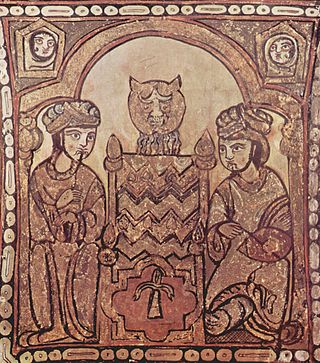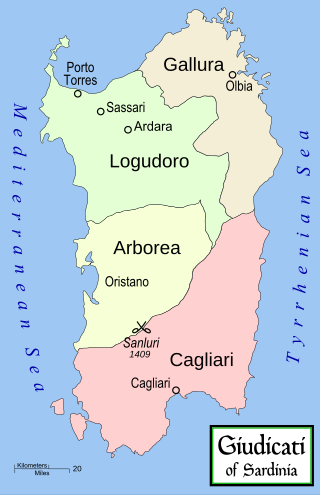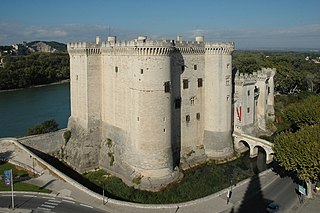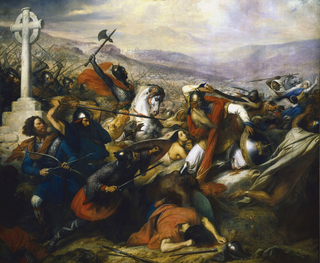This article needs additional citations for verification .(June 2019) |
The Battle of Tourtour of 973 was a significant victory for the Christian forces of William I of Provence over the Andalusi settlers based at Fraxinetum.
This article needs additional citations for verification .(June 2019) |
The Battle of Tourtour of 973 was a significant victory for the Christian forces of William I of Provence over the Andalusi settlers based at Fraxinetum.
For several decades, the Saracens had been making inroads into Provence, building several fortresses, the greatest of which was at Fraxinetum, the castle of La Garde-Freinet. From these bases, they raided and pillaged, capturing goods and people to be sold in far-off Muslim ports. [1] Though they resisted strongly at first, soon the Provençals settled down to a more passive resistance.
However, early in 973, the Saracens captured Maïeul, Abbot of Cluny, and demanded a ransom. Much venerated by his monks, his ransom was quickly obtained. The monks responded, however, once their abbot was released, by stirring up a fury in Provence against the Andalusian menace. The peasantry and the nobles were united in their antipathy towards the Andalusis and together implored their ruler, Count William, to act against them.
William, equally disturbed by the treatment of the abbot, raised a feudal host and took to the offensive. His army consisted not only of men from Provence, but also the lower Dauphiné and Nice.
William's strategy was simple: he struck at the heart of Saracen Provence with the whole of his force. This did not go unnoticed by Andalusians, who went out to meet the Provençals in the Alps. They were defeated in a series of five battles at Embrun, Gap, Riez, Ampus, and Cabasse. Thoroughly beaten back, the Saracens assembled in an open plain called Tourtour not far from Fraxinetum. There, the sixth and final battle of the war was fought. William defeated the Andalusians in the field and chased them back to Fraxinetum, where they sheltered while the Provençals rested.
After a brief break from campaigning, William made an assault on Fraxinetum. This attack was led by the lords of Levens, Aspremont, Gilette, Beuil, and Sospel. With La Garde-Freinet taken, the Andalusis were cut off in Fraxinetum, which was soon seized. The remainder of the Muslim army fled to a nearby forest, where they were soon overcome and entirely captured or killed.
La Garde-Freinet was razed to the ground. Surviving Andalusis were baptized and made to work as slaves. All remaining Muslims in Provence quickly departed by ship without waiting for any further reprisals.
For this campaign and its success at expelling all the Andalusis from Provence, William was called "the Liberator" and "Pater Patriae".

Provence is a geographical region and historical province of southeastern France, which extends from the left bank of the lower Rhône to the west to the Italian border to the east; it is bordered by the Mediterranean Sea to the south. It largely corresponds with the modern administrative region of Provence-Alpes-Côte d'Azur and includes the departments of Var, Bouches-du-Rhône, Alpes-de-Haute-Provence, as well as parts of Alpes-Maritimes and Vaucluse. The largest city of the region and its modern-day capital is Marseille.

William of Gellone, the medieval William of Orange, was the second Duke of Toulouse from 790 until 811. In 804, he founded the abbey of Gellone. He was canonized a saint in 1066 by Pope Alexander II.
Fraxinetum or Fraxinet was the site of a Muslim fortress in Provence between about 887 and 972. It is identified with modern La Garde-Freinet, near Saint-Tropez. From this base, the Muslims raided up the Rhône Valley and into Piedmont. For a time, they controlled the passes through the western Alps. They withstood several attempts to oust them, but were finally defeated by the combined forces of the Provençal and Piedmontese nobility.

Peter the Venerable, also known as Peter of Montboissier, was the abbot of the Benedictine abbey of Cluny. He has been honored as a saint, though he was never canonized in the Middle Ages. Since in 1862 Pope Pius IX confirmed his historical cult, and the Martyrologium Romanum, issued by the Holy See in 2004, regards him as a Blessed.

The Abbey of Saint-Victor is a former abbey that was founded during the late Roman period in Marseille in the south of France, named after the local soldier saint and martyr, Victor of Marseilles.
Majolus of Cluny was the fourth abbot of Cluny. Majolus was very active in reforming individual communities of monks and canons; first, as a personal commission, requested and authorized by the Emperor or other nobility. Later, he found it more effective to affiliate some of the foundations to the motherhouse at Cluny to lessen the likelihood of later relapse.
William I, called the Liberator, was Count of Provence from 968 to his abdication. In 975 or 979, he took the title of marchio or margrave. He is often considered the founder of the county of Provence. He and his elder brother Rotbold I were sons of Boson II of Arles and his wife Constance, who, based on her name, has been speculated to be daughter of Charles Constantine of Vienne. They both carried the title of comes or count concurrently, but it is unknown if they were joint-counts of the whole of Provence or if the region was divided. His brother never bore any other title than count so long as William lived, so the latter seems to have attained a certain supremacy.

The history of Islam in Sicily and Southern Italy began with the first Arab settlement in Sicily, at Mazara, which was captured in 827. The subsequent rule of Sicily and Malta started in the 10th century. The Emirate of Sicily lasted from 831 until 1061, and controlled the whole island by 902. Though Sicily was the primary Muslim stronghold in Italy, some temporary footholds, the most substantial of which was the port city of Bari, were established on the mainland peninsula, especially in mainland Southern Italy, though Muslim raids, mainly those of Muhammad I ibn al-Aghlab, reached as far north as Naples, Rome and the northern region of Piedmont. The Arab raids were part of a larger struggle for power in Italy and Europe, with Christian Byzantine, Frankish, Norman and local Italian forces also competing for control. Arabs were sometimes sought as allies by various Christian factions against other factions.
Arduin Glaber was count of Auriate from c. 935, count of Turin from c. 941/942, and Margrave of Turin from c. 950/964. He placed his dynasty, the Arduinici, on a firm foundation and established the march of Turin through conquests and royal concessions. The Chronicon Novaliciense, the chronicle of the abbey of Novalesa, is the primary source for his life.
The crusade of Barbastro was an international expedition, sanctioned by Pope Alexander II, to take the Spanish city of Barbastro, then part of the Hudid Emirate of Lārida. A large army composed of elements from all over Western Europe took part in the siege and conquest of the city (1064). The nature of the expedition, famously described by Ramón Menéndez Pidal as "a crusade before the crusades", is discussed in historiography, and the crusading element of the campaign is still a moot point.

Le Plan-de-la-Tour is a commune in the Var department in the Provence-Alpes-Côte d'Azur region in southeastern France.

Isarn was the Bishop of Grenoble from 950 until his death in 976. During the reign of Conrad the Peaceful he was instrumental in re-asserting Christian political authority in the south of the Kingdom of Burgundy, overrun by Saracens, and in restoring the shattered Church in the region. His methods in expelling the Saracens from his diocese, were similar to those used by his successful contemporary, William the Liberator in Provence.

The Battle of Monte Laturce, also known as the second Battle of Albelda, was a victory for the forces of Ordoño I of Asturias and his ally García Íñiguez of Pamplona. They defeated the latter's uncle and former ally, the Banu Qasi lord of Borja, Zaragoza, Terrer, and Tudela, Navarre, Musa ibn Musa al-Qasawi, a marcher baron so powerful and independent that he was called by an Andalusi chronicler "The Third King of the Spains" (Spaniae). The battle took place during the Asturian siege of a new fortress under construction by Musa at Albelda de Iregua. The fortress was taken a few days after the battle. After Monte Laturce, Musa was forced to fully submit to the Emir of Córdoba, who took advantage of Musa's weakness to remove him as wāli of the Upper March, initiating a decade-long eclipse of the Banu Qasi.

In 1015 and again in 1016, the forces of Mujāhid al-ʿĀmirī from the taifa of Denia and the Balearics, in the east of Muslim Spain (al-Andalus), attacked Sardinia and attempted to establish control over it. In both these years joint expeditions from the maritime republics of Pisa and Genoa repelled the invaders. These Pisan–Genoese expeditions to Sardinia were approved and supported by the Papacy, and modern historians often see them as proto-Crusades. After their victory, the Italian cities turned on each other, and the Pisans obtained hegemony over the island at the expense of their erstwhile ally. For this reason, the Christian sources for the expedition are primarily from Pisa, which celebrated its double victory over the Muslims and the Genoese with an inscription on the walls of its Duomo.

The historic French province of Provence, located in the southeast corner of France between the Alps, the Mediterranean, the river Rhône and the upper reaches of the river Durance, was inhabited by Ligures beginning in Neolithic times; by the Celtic since about 900 BC, and by Greek colonists since about 600 BC. It was conquered by Rome at the end of the 2nd century BC. From 879 until 1486, it was a semi-independent state ruled by the Counts of Provence. In 1481, the title passed to Louis XI of France. In 1486 Provence was legally incorporated into France. Provence has been a part of France for over 400 years, but the people of Provence, particularly in the interior, have kept a cultural identity that persists to this day.

The Umayyad invasion of Gaul occurred in two phases in 719 and 732 AD. Although the Umayyads secured control of Septimania, their incursions beyond this into the Loire and Rhône valleys failed. By 759 they had lost Septimania to the Christian Franks, but would return in the 10th century to establish Fraxinetum based in Provence.
The Battle of Fraxinet or Fraxinetum was fought around 20 May 942, between a Hungarian raiding army and the Muslim frontier state of Fraxinet, and ended with a Hungarian victory.
The Brabançons or Brabanters were routiers originally from the Duchy of Brabant active between 1166 and 1214.

Laugier of Nice, known as the Roux, is also known as Laugier of Orange-Mévouillon or Laugier of Vence. He was co-lord of Nice, Gréolières, Cagnes and Vence. He held these titles in part through his wife Odile of Provence and his father-in-law, William I of Provence. Laugier seems to be related to the Mévouillon-Orange lineage. Some historians give him the title of viscount. He was a member of the first house of the counts of Orange-Nice. From 1023 Laugier was a monk of the order of Cluny.
The Muslim presence in medieval France corresponds to the Saracen presence for several periods between 719 and 973 in the province of Septimania and then in Provence until 1197, of Muslim populations, mainly Arabs, Berbers, and also Europeans who converted to Islam (Muwallads).